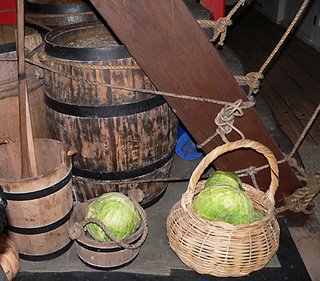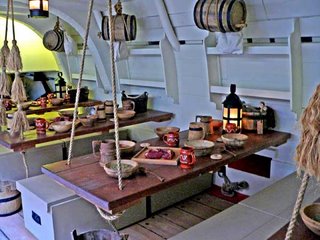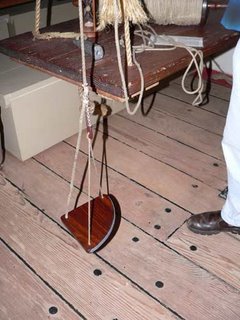 The Ship's Cat a VIP - in the Mess Deck. really a stuffed cat
The Ship's Cat a VIP - in the Mess Deck. really a stuffed cat
The first place we were shown below the main deck was the galley - or ships kitchen. This was a narrow floor space in front of a huge iron stove/oven that burned wood. It had huge pots of stew and gruel for the men and a spit for roasting meat for the officers and the ill. There were many measures around this furnace designed to prevent fire on board. We were shown the appalling looking barrels of salted pork, another with sauerkraut to prevent scurvy, another with potatoes. Alongside all this were some fresh vegetables that the sailors would get eveytime they would dock.
Aft or towards the back of the ship from this stove - galley area was the eating / sleeping / relaxing area for most of the crew of 94 people on Cook's voyage.
The seats at these table were the trunks for the clothes and possessions of the crew. And cats were good to keep down the rats which always plaque ships and wharfs. The tables were suspended from the roof so they could remain level but as the men were sitting on the trunks to eat, the table and plate of food would move with the swells...
No person on board died of scurvy after a 3 year journey which was amazing for this era. In 1747 a the Scottish naval surgeon Dr James Lind showed that having daily oranges and lemons scurvy could be prevented. His was not believed but Captain Cook realised it was important so insisted on all his crew eating them daily. Amazingly it took another 50 years for the British Admiralty to prescribe a daily ration of lemon juice for all sailors in the Navy. However a total of 30 of Cook's passengers and crew of all ranks died - mostly from dysentery contracted in ports of Batavia [Indonesia] and South Africa. There were no showers - or washing facilities for the crew. The Captain had a wash bowl and a mirror and officers all had a chamber pot under their bed. The front of the ship or head of ship had a board to sit on out over the edge of the ship with big hole in it for a toilet. Hence saiors refer to the t lavatory as the "head" . In the days of cook it was called the "seat if ease". The officers quarters were all at the rear of the ship- far away from this area. Their meals were even prepared up there too but cooked in the main galley.
The type of hat a man wore indicated his rank - see the three hats on a rack in photo.
In the Mess Deck the men slept in hammocks that had to be folded very small and stowed just under the rafters above the dining tables during the day. To test if the hammock was folded tightly enough it had to pass through this rope loop.





